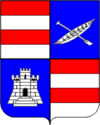Ston
| Ston | |
|---|---|
|
Mali Ston | |
 Ston The location of Konavle within Croatia | |
| Coordinates: 42°50′N 17°42′E / 42.833°N 17.700°ECoordinates: 42°50′N 17°42′E / 42.833°N 17.700°E | |
| Country | Croatia |
| County | Dubrovnik-Neretva county |
| Government | |
| • Mayor | Vedran Antunica |
| Elevation | 0 m (0 ft) |
| Population (2011)[1] | |
| • Total | 2,407 |
| Time zone | CET (UTC+1) |
| • Summer (DST) | CEST (UTC+2) |
| Postal code | 20 230 |
| Area code(s) | +385 20 |
| Vehicle registration | DU |
| Website |
www |
Ston (pronounced [stɔ̂n] is a village and municipality in the Dubrovnik-Neretva County of Croatia, located at the south of isthmus of the Pelješac peninsula. The town of Ston is the center of the Ston municipality.
Municipality
In the 2011 census, the total population of the municipality of Ston was 2,407, in the following settlements:[1]
- Boljenovići, population 87
- Brijesta, population 58
- Broce, population 87
- Česvinica, population 55
- Dančanje, population 27
- Duba Stonska, population 36
- Dubrava, population 133
- Hodilje, population 190
- Luka, population 153
- Mali Ston, population 139
- Metohija, population 157
- Putniković, population 82
- Sparagovići, population 114
- Ston, population 549
- Tomislavovac, population 104
- Zabrđe, population 61
- Zamaslina, population 79
- Zaton Doli, population 61
- Žuljana, population 235
In the same census, Croats made up an absolute majority with 98.50% of the population.[2]
History
Ston is known for its saltworks which were run by the Republic of Ragusa and the Ottoman Empire.
In antiquity this region was populated by Illyrians and Greeks and from 167 BCE the Romans rule over the area. In the second century one of the Roman maps lists all the major strategic town and cities including Perdua or Stamnes, which was on the southern and western hill St. Michael. In 877 the Ston bishopric was created and becomes the seat of the rulers of Zahumlje. During the rule of Croatian kings Višeslav to Zvonimir (i.e., from 9th through 12th century), the Duke of Zahumlje was under their protectorate and the bishop was the suffragan bishop subordinate to Split bishop. When Croatia entered the state union with Hungary in 1102, Zahumlje is ruled by Doclea and Byzanthium and the Ston bishop becomes the suffragan of Dubrovnik bishop. In 1168 the dynasty of Nemanjić subordinated Doclea and Zahumlje; the Raša duke Deša gifts Mljet to the Benedictines. In Raška Sava Nemanjić reorganizes the church, founds new bishoprics and places Ston and Pelješac under the rule of his episcopates. The domination of Stone by Raška lasts for some 150 years. In 1325, the ruler of Zahumlje becomes Bosnian ban Stjepan Kotromanić. Kotromanić rulers were at that time in conflict with Serbian župans. Dubrovnik takes advantage of the conflict and places Ston and Pelješac under its rule. After many dynastic changes, including the local dukes of Zahumlje, the Croatian nobles, Raša župans, and Bosnian nobility, in 1333 Dubrovnik gains permanent possession of Ston and Rat, and this is a new chapter in the history of this area. The new Ston is being built, the saltworks are being renovated and Ston gets a Duke (knez). It is being populated by 150 Dubrovnik families. In 1359, Ston and Mali Ston (Little Ston) were encircled by a double defensive wall and became “invincible.”
Cultural monuments
Walls of Ston
Ston was a major fort of the Ragusan Republic whose defensive walls were regarded as a notable feat of medieval architecture. The town's inner wall measures 890 metres in length, while the Great Wall outside the town has a circumference of 5 km. The walls extend to Mali Ston ("Little Ston"), a smaller town on the northern side of the Pelješac isthmus and the end of the Bay of Mali Ston, notable for its mariculture.
See also
Gallery
-

Saint Blaise Church in Ston, Croatia
-

Street in Ston, Croatia
-

City Centre in Ston, Croatia
-

Street in Ston, Croatia
-

Street in Ston
-

Entrance to Ston City Walls in Croatia
-

Anguis fragilis, or slow worm, in Ston, Croatia
References
- 1 2 "Population by Age and Sex, by Settlements, 2011 Census: Ston". Census of Population, Households and Dwellings 2011. Zagreb: Croatian Bureau of Statistics. December 2012.
- ↑ "Population by Ethnicity, by Towns/Municipalities, 2011 Census: County of Dubrovnik-Neretva". Census of Population, Households and Dwellings 2011. Zagreb: Croatian Bureau of Statistics. December 2012.
Ćosić, Stjepan. “The Nobility of the Episcopal Town of Ston (Nobilitas civitatis episcopalis Stagnensis) Dubrovnik Annals, Vol. No. 5, 2001.
Gudelj, Krešimira. “Coastal toponymy of the Ston region,” Folia onomastica Croatica, Vol. No. 20, 2011Melita Peharda, Mirjana Hrs-Brenko, Danijela Bogner, “Diversity of bivalve species in Mali Ston Bay, Adriatic Sea," Acta Adriatica, Vol. 45 No. 2, 2004.
Lupis, Vinicije B. , “Mediaeval crucifixes from Ston and its surrounding area,” Starohrvatska prosvjeta, Vol. III No. 38, 2011.
Miović, Vesna. "Emin (Customs Officer) as Representative of the Ottoman Empire in the Republic of Dubrovnik," Dubrovnik Annals 7 (2003): pp. 81–88.
Tomšić, Sanja, and Josip Lovrić. “Historical overview of oyster culture in Mali Ston Bay,” Naše more, Znanstveno-stručni časopis za more i pomorstvo, Vol. 51 No. 1-2, 2004.
Andrej Žmegač. “The Ston Fortification Complex - Several Issues,” Prilozi povijesti umjetnosti u Dalmaciji, Vol. 39 No. 1, 2005
External links
| Wikimedia Commons has media related to Ston. |
| ||||||||||||


